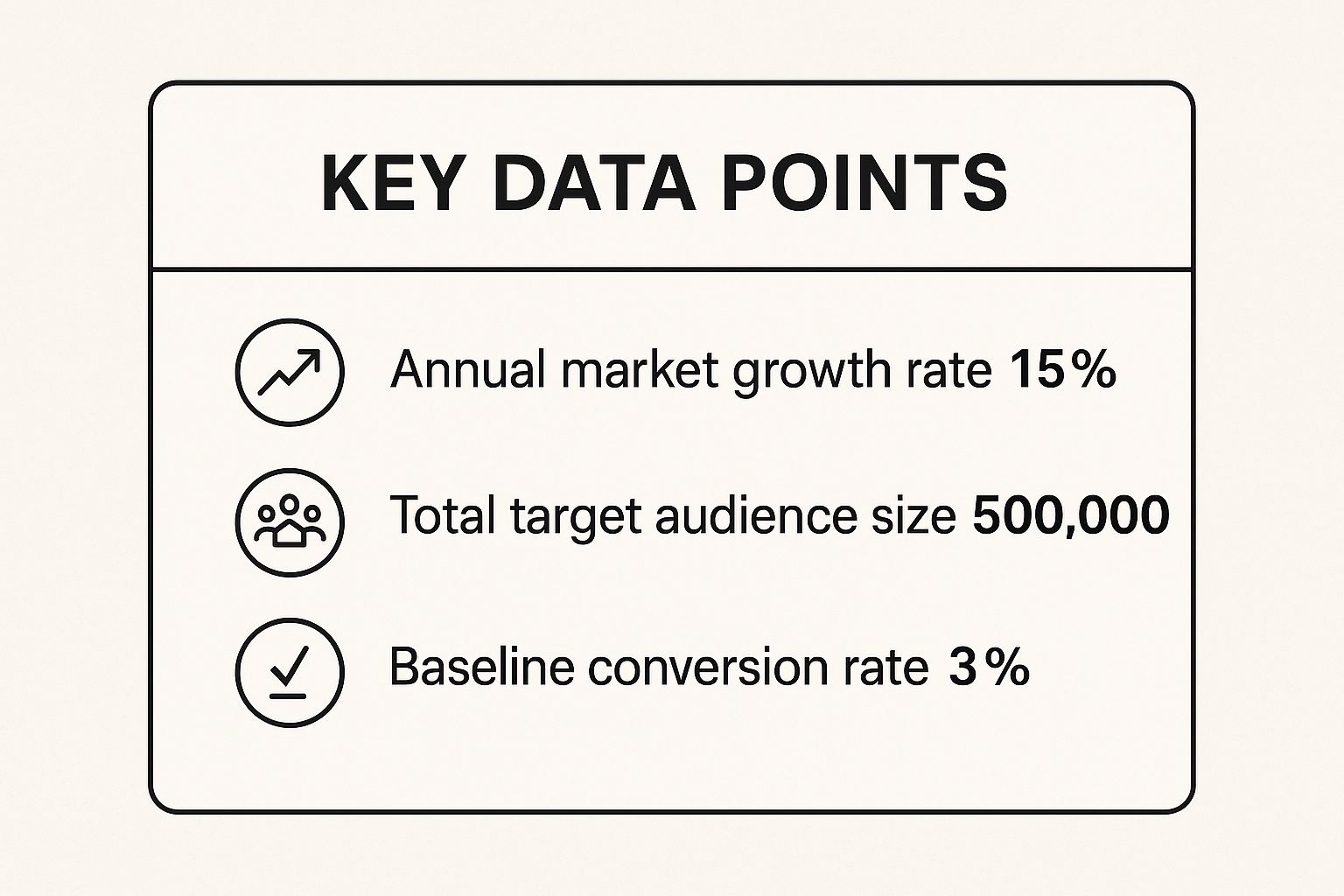A startup marketing strategy isn't just a list of tactics. It's the blueprint that guides how your new business finds its audience, proves its worth, and starts growing. It's what separates calculated growth from just randomly throwing money at ads and hoping something sticks.
Building Your Foundational Startup Marketing Strategy

Before you even think about your first ad campaign or blog post, you have to lay the groundwork. This early-stage work is what keeps you from burning through your limited cash. A great idea is one thing, but a great idea with a clear path to the right people is what actually builds a business.
This foundational stage is all about asking the tough questions. Who are you really selling to? What problem are you solving that keeps them up at night? And why on earth should they choose you over all the other options they have? Getting honest answers here is often the difference between a startup that fizzles out and one that finds its footing and scales.
Defining Your Ideal Customer Persona
You can't just aim for "everyone." You need to know your customers on a deeper level than they might even know themselves. Generic demographics are a starting point, but they're not enough. You need to build a customer persona—a detailed, semi-fictional profile based on real-world data and solid market research. Give this person a name, a job, and, most critically, a list of their biggest frustrations.
For example, don't just target "small business owners." Create "SaaS Sarah." She's 34, runs a 10-person tech startup, and is constantly annoyed by productivity tools that refuse to talk to each other. Her biggest headache is the hours her team wastes on manual data entry. She reads tech blogs religiously, always looking for an edge. Suddenly, you're not just selling software; you're solving a specific, painful problem for a real person.
Conduct Meaningful Competitor Analysis
Your competitors are more than just a list of names to worry about; they're a treasure trove of market intelligence. A smart analysis of what they're doing—and more importantly, what they're not doing—can reveal huge opportunities.
- Product Gaps: Are customers complaining in reviews about a feature your competitors refuse to build? That's an opening.
- Content Gaps: What topics related to your industry are they completely ignoring on their blog or social media? Your audience (like "SaaS Sarah") is probably searching for that content.
- Channel Gaps: Maybe they're all over LinkedIn but have zero presence in the niche Reddit communities or Slack groups where your ideal customers actually hang out.
This kind of analysis isn't about copying; it's about finding the gaps they've left for you to fill. If you're looking for real-world inspiration, checking out different https://refgrow.com/blog/startup-marketing-strategies can show you how others have successfully carved out their own space.
Your social media marketing plan is a critical piece of this foundation. It's not just about posting; it's a document that details how you'll engage with your audience on the platforms they use every day, ensuring your efforts are focused from day one.
Establish a Unique Value Proposition
Your Unique Value Proposition (UVP) is the heart of your messaging. It's a short, powerful statement that tells people exactly what you do, how you solve their problem, and what makes you different from everyone else. A great UVP is punchy, pain-focused, and unique to you.
A generic, forgettable UVP sounds like this: "We sell project management software."
A strong, specific UVP is much better: "Our project management tool helps remote teams cut down on meetings by 40% by centralizing communication and automating status updates." See the difference? It tackles a specific pain (too many meetings) and promises a concrete, quantifiable result.
Set Realistic SMART Goals
Finally, a strategy without goals is just a dream. You need to know what success looks like, and the SMART framework is perfect for this. It forces you to define objectives that are actually trackable and achievable.
- Specific: What, exactly, do you want to accomplish?
- Measurable: How will you track progress and know when you've succeeded?
- Achievable: Is this goal realistic given your time, team, and budget?
- Relevant: Does this goal actually help your overall business grow?
- Time-bound: When will this be done?
Don't just say, "We need more website traffic." A SMART goal sounds like this: "Increase organic website traffic from 500 to 2,000 visitors per month by the end of Q3 by publishing eight new, search-optimized blog posts." Now you have a clear target, a deadline, and a plan to make it happen.
Choosing Lean Marketing Channels for Maximum Impact
Now that you have your foundation, it’s time to get into the action. But for a startup, "action" doesn't mean launching a full-scale marketing blitz across every channel imaginable. That’s a fast track to burning through your cash and your morale. The real key is making smart, deliberate choices about where to spend your limited time and money.
Think of it like fishing. You wouldn't just cast your line randomly into the ocean; you'd go where you know the fish are biting. Your job is to find those one or two channels where your ideal customers are already hanging out and then completely own that space. Resist the urge to chase every shiny new platform and instead make calculated bets based on your audience and product. This is how you'll score those critical early wins that build momentum for everything else.
To get started, you need to understand the potential of the market you're entering. Tracking key metrics from the get-go helps you frame the opportunity and gives you a baseline for measuring what's working and what's not.

Building Your Organic Growth Engines
For most startups, the most durable growth comes from channels you own, not ones you rent. Think SEO and content marketing. Yes, they take a real investment of time and creativity upfront, but the payoff can be massive and long-lasting. Unlike a paid ad that vanishes the second you stop funding it, a top-ranking blog post can keep bringing you qualified leads for years.
The trick here is to be surgical. Don't waste your energy trying to rank for huge, competitive keywords. Instead, get smart about long-tail keywords—those longer, more specific phrases people type in when they’re much closer to buying. For example, instead of targeting "project management software," you might go after "project management software for small creative agencies." You’ll face less competition and attract a much more qualified audience.
So many founders underestimate the grind required for organic growth. It’s not a one-and-done task. You need to consistently create helpful content, stay on top of technical SEO, and build relationships to earn links. It's a marathon, not a sprint.
Making a Splash with Targeted Social Engagement
Social media can feel like a chaotic mess of platforms, each demanding your attention. The lean startup approach? Pick one or two networks where your customer personas actually live and go all-in. Being a faint whisper on five different platforms is a waste of time. Becoming a dominant voice on one can build you a loyal tribe.
Once you’ve picked your battleground, the focus has to be on genuine engagement, not just shouting into the void.
- Lead with Value: Share useful tips, ask interesting questions, and offer help with no strings attached. Build goodwill first.
- Speak the Language: What crushes it on LinkedIn (professional insights, longer text posts) will die a slow death on TikTok. Create content that feels native to the platform.
- Stick Around and Chat: Don't just post and run. Reply to comments, jump into relevant conversations, and make your followers feel seen and heard.
For many new companies, working with trusted voices in your niche can be a powerful shortcut. Digging into effective influencer marketing strategies for startups can show you how to partner with people who already have the attention and trust of your target audience.
This focused strategy builds real relationships and brand loyalty far better than a scattered, impersonal presence ever could. It’s about the quality of your interactions, not the sheer quantity of your posts.
A Quick Look at Your Options
Choosing where to start can be tough. The table below breaks down a few common channels to help you compare the typical cost, effort, and long-term potential for an early-stage company.
| Channel | Typical Startup Cost | Time/Effort Required | Potential Long-Term ROI |
|---|---|---|---|
| SEO/Content Marketing | Low (mostly time) | High & Consistent | Very High |
| Paid Social (e.g., Meta) | Scalable (from $10/day) | Medium | Medium to High |
| Email Marketing | Low to Medium | Medium | High |
| Influencer Marketing | Varies Widely | Medium | High |
| Community Building | Low (mostly time) | High & Consistent | Very High |
This isn't an exhaustive list, but it highlights the trade-offs you'll need to consider. A smart strategy often involves a primary focus on one organic channel (like SEO) supported by a more immediate, targeted channel (like paid social) to get initial traction.
Ultimately, your channel mix should be guided by data and a deep understanding of your customer. By focusing on a select few high-ROI channels, you create a marketing engine that is both resilient and cost-effective, ensuring every bit of effort moves you closer to the customers who need you most.
Crafting Content That Actually Builds an Audience

Let's be honest: just hitting "publish" on a blog post and hoping for the best is a fast track to obscurity. In startup marketing, your content is the engine, but it needs the right kind of fuel. You need to create content with a clear job to do—whether that's attracting new eyes, engaging your core audience, or gently guiding them toward becoming a customer.
This means you have to stop thinking like a publisher and start thinking like a problem-solver. Your product was built to fix something, right? Your content should do the same. This simple shift builds trust and positions you as a helpful expert, not just another company trying to make a sale. You're earning attention, not just buying it.
Establish Your Core Content Pillars
Instead of chasing every shiny new topic, ground your efforts in a few core content pillars. These are the big-picture themes that live at the sweet spot where your audience's biggest headaches meet your product's best solutions. Think of them as the main categories on your company’s bookshelf.
For instance, if your startup offers a project management tool for remote teams, your pillars might look something like this:
- Remote Team Productivity: Actionable guides, videos, and articles on how to stay sharp and efficient when working from home.
- Asynchronous Communication: Content that teaches teams how to collaborate smoothly across different continents and time zones.
- Project Management Best Practices: Deep dives into frameworks and tutorials for pulling off complex projects without a hitch.
Sticking to these pillars makes every piece of content you create feel relevant and reinforces what you're an expert in. That consistency is what turns casual readers into a dedicated audience that trusts you. For startups, especially in SaaS, a solid content plan is non-negotiable, a point detailed in this complete SaaS content marketing strategy guide.
Go Deep with High-Value Long-Form Content
In a world obsessed with 15-second videos, going long might feel like you're swimming upstream. But here’s a secret: in-depth, high-value content often delivers the biggest wins. A truly comprehensive guide or a detailed tutorial provides so much value that people are eager to share it, and search engines love it.
We've seen it time and time again: depth drives real engagement. In fact, articles between 1,000 and 2,000 words tend to get about 56.1% more social shares than shorter posts. It’s a clear signal that audiences reward quality and effort.
A single, meticulously researched pillar post—imagine a 3,000-word "Ultimate Guide to Asynchronous Communication"—can become a powerful asset for your startup. It doesn't just pull in organic traffic for months or years; it also makes for a fantastic lead magnet. People will happily give you their email address for a downloadable PDF of that kind of resource.
Embrace a Multi-Format Approach
You just poured a ton of work into that epic pillar post. Don't let it be a one-hit-wonder. The smartest marketers I know don't just publish content once; they repurpose it across every format and channel imaginable. That single guide can be sliced and diced into a dozen smaller pieces.
Here’s how that one "Ultimate Guide" can get a second, third, and fourth life:
- Short-Form Videos: Pull 10 distinct tips and turn each into a 60-second TikTok or Reel.
- Infographics: Create a sharp, visual summary of the key stats and frameworks for Pinterest and LinkedIn.
- Email Newsletter Series: Break the guide into a 5-part "masterclass" delivered straight to your subscribers' inboxes.
- Social Media Carousels: Design engaging, swipe-friendly carousels for Instagram that teach one concept per slide.
- Podcast Episode: Host a deep-dive conversation about the guide's main ideas with your founder or a guest expert.
This "create once, distribute forever" mindset multiplies the reach of your best work without burning out your team. It’s how you show up everywhere your audience is, ready to help whether they prefer to read, watch, or listen.
Ultimately, a strong content engine isn't about feeding an algorithm; it’s about building relationships at scale. When you consistently show up and solve real problems, you create a loyal following that not only loves your content but is also far more likely to become paying customers. This is fundamental to improving the long-term value of every user you bring on board, a concept we explore more in our guide on how to increase customer lifetime value.
Using Hyper-Personalization to Stand Out
Let's be honest. In a market flooded with options, generic marketing messages are the quickest way to get ignored. Your customers have developed a finely tuned filter for bland, one-size-fits-all content. This is where hyper-personalization becomes your unfair advantage—it’s how you cut through the noise by making every single person feel seen and understood.
We're talking about moving past broad labels like "small business owners" and getting into the nitty-gritty. This means using real-time data and accessible AI to create experiences that feel less like a sales pitch and more like a helpful, one-on-one conversation. Even on a shoestring budget, you can make customers feel like your product was built just for them, which is a killer way to build loyalty right from the start.
Beyond Just Using Their First Name
True personalization is so much more than dropping a {{first_name}} tag into an email subject line. That's the bare minimum these days. A truly effective startup marketing strategy digs into behavioral data to tailor every single touchpoint.
Imagine a new user signs up for your SaaS trial. After three days, they still haven't touched one of your most valuable features. The old way is to send a generic "Hey, are you still there?" email. The hyper-personalized approach is different.
An automated system could send a message like this: "We noticed you haven't tried our reporting feature yet. Here’s a 90-second video showing how it can save you hours on weekly updates."
This simple, triggered action is a game-changer because:
- It directly addresses a user’s specific inaction.
- It offers an immediate, tangible solution to a problem they might not even know they have.
- It proves you're paying attention to their journey.
That small touch transforms a marketing message from an annoying interruption into a genuinely helpful nudge.
"Your customers don't care about your product. They care about their problems. Personalization is the bridge between your product's features and their specific problems."
Customize the Experience on Your Website
Your website shouldn’t be a static, lifeless brochure. Think of it as a dynamic environment that adapts to whoever is visiting. Using modern tools, you can easily change headlines, calls-to-action, and even testimonials based on where a visitor came from or what they’ve already done on your site.
For example, if someone lands on your site from a Google search for "accounting software for freelancers," your homepage headline can instantly shift from "The Best Accounting Software for Small Business" to "The #1 Accounting Software for Freelancers." It's a subtle change, but it immediately signals to the visitor that they're in the right place. This simple tweak can dramatically lower bounce rates and pull people deeper into your site.
This isn’t just a nice-to-have; it’s a critical trend. Startups are moving away from broad segments and toward creating hyper-specific profiles, sometimes for individual users. This allows for incredibly customized experiences, from tailored pricing to personalized landing pages. You can find more insights on this and other startup industry trends on Stripe.com.
Predictive Recommendations That Actually Help
Another incredibly powerful tool in your arsenal is predictive analytics. You don't need a Netflix-sized budget to do it, either. The core idea is simple: suggest products, features, or content that will genuinely help your user.
By analyzing behavior—like which blog posts they read or features they use most—you can make intelligent recommendations. A user who keeps reading articles about "team collaboration" could be shown a case study about how another company improved teamwork using your tool. This isn't a random upsell; it's a relevant, data-informed suggestion that adds real value and guides the user toward getting more out of your product.
When you get this right, your marketing starts to feel less like a sales pitch and more like a concierge service. You're not just selling; you're helping. That's how you build the kind of trust that turns your first users into your most passionate, lifelong advocates.
Measuring What Matters to Iterate Your Strategy

Let's be blunt: a startup marketing plan without a way to measure success is just wishful thinking. Launching campaigns and creating content is only the first step. The real magic, the kind that leads to sustainable growth, happens when you start listening to what the data tells you. This is how you find out what to double down on and what to cut loose.
It’s easy to get sidetracked by what we call vanity metrics. A sudden spike in social media likes or a video that goes viral feels great, but it doesn't pay the bills. The trick is to focus on the key performance indicators (KPIs) that truly signal the health and momentum of your business. These are the numbers that prove your marketing is actually making a difference to your bottom line.
Focusing on Actionable KPIs
Instead of drowning in a sea of data, a smart startup zeroes in on a few crucial metrics. These are the numbers that tell the real story of your customer journey and your financial health.
Every founder should have these essential KPIs on their radar:
- Customer Acquisition Cost (CAC): This is your total sales and marketing spend divided by the number of new customers you brought in. Simply put, how much does it cost to get one new person to buy from you? Your goal is to keep this number as low as possible.
- Customer Lifetime Value (LTV): This metric projects the total revenue you can expect from a single customer throughout their entire relationship with your company. A high LTV tells you you're attracting the right kind of customers—and keeping them.
- Conversion Rate: This is the percentage of people who take a specific action you want them to take, whether it's signing up for a trial, booking a demo, or making a purchase. It’s a direct measure of how effective your messaging and product actually are.
A healthy startup almost always has an LTV that is significantly higher than its CAC. A good rule of thumb to aim for is an LTV/CAC ratio of 3:1 or better. This proves you aren't just buying customers; you're building a profitable business.
Don't get distracted by metrics that feel good but mean nothing. Your goal isn't to be popular; it's to be profitable. Focus relentlessly on the numbers that connect directly to revenue and customer retention.
Building Your Analytics Dashboard
You don’t need a ridiculously complex or expensive business intelligence tool right out of the gate. Honestly, a free tool like Google Analytics can give you a treasure trove of information. The key is to build a custom dashboard that puts your most important KPIs front and center.
This dashboard should become your daily check-in, your single source of truth for marketing performance. It needs to clearly show your CAC, LTV, conversion rates by channel, and traffic from your most important sources. Having this clear view stops you from getting lost in endless reports and helps you spot trends—both good and bad—before they snowball into major problems.
For instance, imagine you see that your conversion rate from organic search is double that of your paid social ads. That’s a powerful signal. It tells you to start shifting more resources into your SEO and content strategy because those visitors are proving to be more valuable. On the flip side, a steadily rising CAC is an early warning that a channel might be getting saturated or less effective.
Creating a Powerful Feedback Loop
Data is completely useless if you don't act on it. The most successful startups I've seen all operate on a continuous feedback loop: Plan, Execute, Measure, Iterate. You've already done the planning and execution. Now, the measurement part is what fuels the iteration.
This loop transforms your marketing from a static shot in the dark into a scientific process of constant improvement. Let's walk through a simple A/B test on a landing page:
- Plan: You form a hypothesis: "I believe changing our headline to focus on a key benefit will increase trial sign-ups."
- Execute: You run the test for two weeks, sending 50% of traffic to the original page and 50% to the new version.
- Measure: You check the analytics and discover the new headline boosted the conversion rate by a whopping 22%.
- Iterate: You make the winning headline permanent and immediately start brainstorming your next test.
This cycle isn't just for landing pages; it applies to everything—your content topics, email subject lines, and even your pricing. It’s a foundational piece of modern growth strategies, especially in SaaS. For example, if you're running a partner program, tracking which affiliates drive the highest-quality leads is essential. We dive deeper into this in our guide to SaaS affiliate marketing.
By truly embracing this data-informed approach, your marketing strategy stops being a dusty document and becomes a dynamic, intelligent engine for real, sustainable growth.
Answering Your Top Startup Marketing Questions
Starting a new business is a rush, but that initial excitement is often followed by a wave of questions, especially about marketing. How do you actually get those first customers in the door? Even with a solid plan, founders run into the same practical, in-the-trenches problems.
Let's dive into some of the most common questions we hear from founders who are just starting to build out their marketing. Think of this as a field guide for navigating those early, often confusing, marketing hurdles.
What Is the Most Important Marketing Channel for a New Startup?
This is the big one, the question everyone asks. But the truth is, there’s no magic bullet. The "best" channel isn't a universal answer; it's entirely dependent on where your specific audience hangs out. The whole game is about meeting your customers where they already are, not trying to force them onto a platform you like.
Your own audience research should give you all the clues you need. For example:
- Building a B2B SaaS tool? Your ideal customer is probably digging for solutions on Google and looking for professional insights on LinkedIn. That means your go-to channels should be SEO and focused LinkedIn activity.
- Launching a D2C brand for Gen Z? They’re living on TikTok and Instagram. Your strategy will revolve around short-form video and influencer marketing.
Don't fall into the trap of trying to be everywhere. Spreading yourself thin across five different platforms will get you nowhere. It’s far smarter to find one or two channels that click and really own them. Let your research guide you, focus your limited resources, and aim for maximum impact.
How Much Should an Early-Stage Startup Spend on Marketing?
Ah, the budget question. This is a huge source of stress for founders, and for good reason. How much you should spend really depends on your revenue stage and business model.
For a B2B SaaS startup that has found product-market fit, a common rule of thumb is to reinvest 10-20% of your annual recurring revenue (ARR) back into marketing. This creates a sustainable growth loop where revenue fuels more marketing, which in turn fuels more revenue.
But what if you're pre-revenue or still searching for that perfect product-market fit? In these very early days, your most powerful asset isn't cash—it's your time. You should be pouring your energy into "sweat equity" channels.
- Organic Social Media: Focus on building a genuine community on one key platform.
- Content Marketing: Write truly helpful blog posts that solve your audience's problems.
- Community Engagement: Become a valuable voice in relevant online forums, Slack groups, or subreddits.
Once you find a channel that starts to show consistent, positive results, then you can start dedicating a small, controlled budget to test paid ads and see if you can pour some fuel on the fire.
When Should I Hire My First Marketing Person?
Bringing on your first marketer is a huge milestone. Get the timing right, and you accelerate growth. Get it wrong, and you can burn through cash with little to show for it.
In the very beginning, the founders have to lead marketing. There's no substitute for that hands-on experience. It gives you a gut-level understanding of your customers and what messages actually connect with them. You simply can't delegate something you don't understand yourself.
The right time to make that first hire is when two things are true:
- Marketing tasks are consistently eating up so much of the founders' time that it's pulling you away from other critical jobs, like talking to users or building the product.
- You've found early signs of life in one or two marketing channels and need someone to execute consistently and scale what's already working.
Don't hire a specialist right out of the gate. You don't need a "PPC expert" or a "social media guru" just yet. Your first hire should be a marketing generalist or a "T-shaped" marketer—someone who has a broad understanding of many areas but deep expertise in the one or two channels you've already validated. This gives you the flexibility to manage today's needs while adapting to whatever comes next.
Ready to build a powerful growth engine for your SaaS? Refgrow makes it simple to launch and scale a fully native affiliate program directly within your product. Get your first affiliates onboard in minutes and start accelerating your growth today. Explore Refgrow.

